Have you ever asked students what they don’t like about online courses? If you have or if you’ve ever researched the complaints online students have, you’ll notice one major trend: students want to know the instructor is present, engaged and interested in them.
Since the advent of online courses, students have craved a strong social presence from their instructor. Sure, most students love autonomy and the freedom to direct their own learning, but no one wants to shout into the darkness. Students of all ages want to be part of a community, not a correspondence course. They want to know that their voice is being heard. They want to know that their opinions matter. They want feedback and connection, not isolation.

So how do you establish that social presence and make sure students don’t feel isolated in an online environment?
At VoiceThread, we believe it all starts with your mindset and vision for your course. Do you see your course as a way for you to broadcast information to an audience or do you see it as a way to personally guide students toward knowledge using feedback and questioning? In a MOOC, instructors prepare information for students to consume but they don’t follow up to see if any learning is really happening. Feedback on student work is one of the cornerstones of good pedagogy, and VoiceThread was designed to do just that.
When your students comment on a thread that you share, you will receive instant notifications so you can facilitate learning as it happens. Instead of creating content for students to consume, try creating a VoiceThread so your students can interact with your content and more importantly– with you!

Classroom learning is often criticized for being too removed from authentic experience. Coaches rarely face the same criticism and here are a few reasons why. Coaches generally use most of the following approaches to teaching that can be overlooked in the traditional classroom setting:
- Get to the hands-on practice as soon as possible

Athletes, just like academic students can’t start doing something until they know what it is they should be doing, but coaches know that with limited time they had better use words economically and get the students practicing and developing an understanding as soon as possible. The goal isn’t to show how much experience the teacher has, the goal is to show how much experience the students have. The only way for them to get that experience is through hands-on practice as often as possible.
- Formative assessment is vital
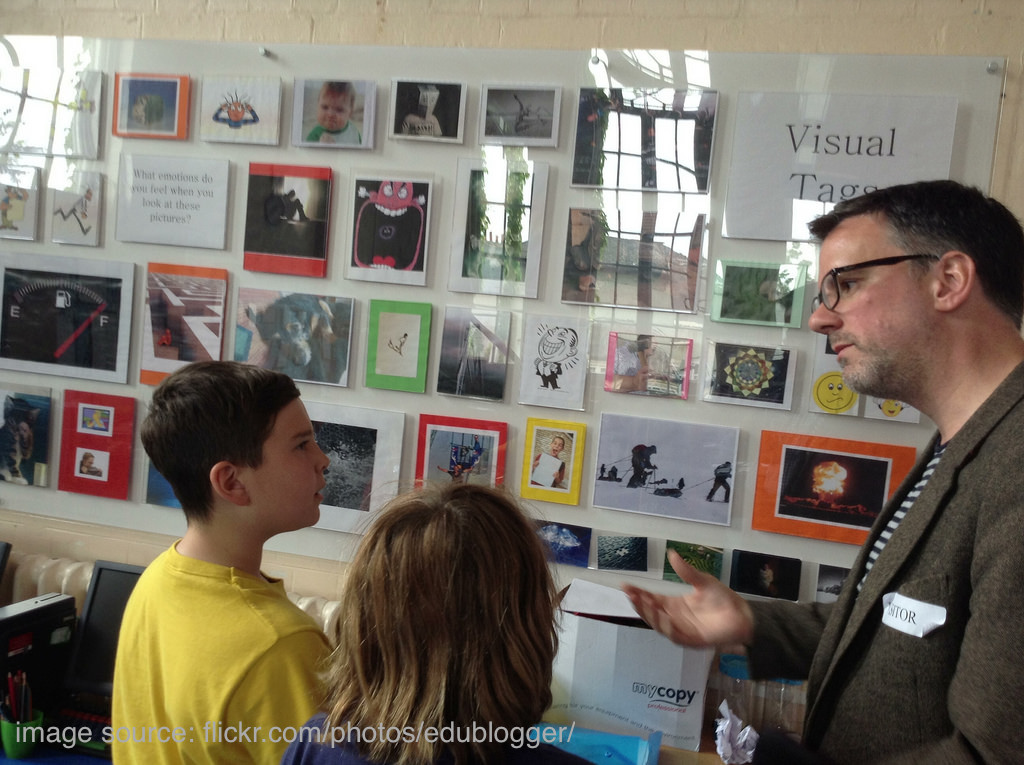
Imagine a coach who never gave feedback during practice and then spent hours after the game evaluating players on those very skills. That would seem sort of crazy. Athletes are used to coaches either praising or correcting them after each attempt they make during practice. Formative assessment is non-stop during practice. In the classroom, students often have to wait days or weeks to be assessed through a tool like a quiz or an exam.
- Authentic assessment is the goal

Would you practice a sport if you knew you’d never play an actual game? Would you listen to your coach if she gave you a multiple-choice exam about the rules and strategies instead of letting you prove your learning on the field? Coaches know that learning the rules and learning the vocabulary are just means to an end. The only yardstick for measuring success is how well the players apply their knowledge in the game. In school we judge students on whether they are familiar with the rules but we don’t judge how well they apply what they learned.
- Emotion is the primary motivator

Unfortunately, a word often associated with school is “boring.” How it this possible? In school we learn about volcanos, world wars, Shakespeare, civil rights, yet somehow we manage to sanitize it of all emotion. Every subject from history to science has emotional resonance. Every subject can bring out joy, wonder, shock and empathy. School should be an emotionally charged experience. Compare a half-time speech during a playoff game versus a lecture about Stalin. We can learn a lot from coaches.
- Data can make us better
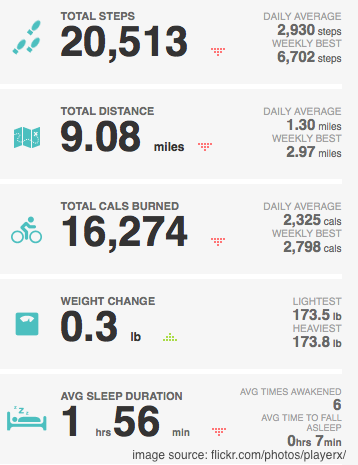
Coaches use data all the time. They record statistics, tendencies and many other valuable data points. They take all that information and tell a story with math. The story might be “We’ve found our opponents’ weakness and here’s our plan to exploit it” or “We’ve found our weakness and here’s our plan to correct it.” In essence, the next week’s game plan is data-driven design.
Can you think of any other lessons that classroom teachers can learn from coaches? Let us know in the comments below!

This is a guest post by Educator and VoiceThreader, Mary Ellen Davies.
De Pere, Wisconsin and Hillsborough, New Jersey are separated by 999 miles. Without traffic, it would take over 14 hours to drive between these two towns. Given this large geographical gap, it might be surprising to know that students from De Pere Middle School and Hillsborough Middle School spent 4 days reading and critiquing poems together. With the help of VoiceThread, this asynchronous connection was possible.
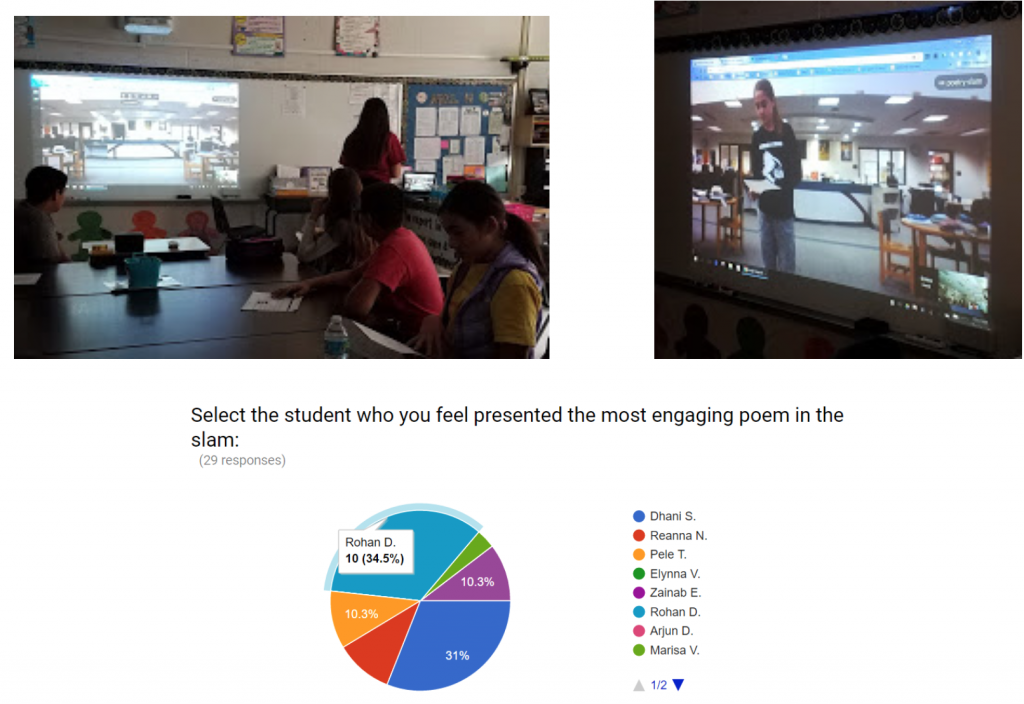
Donna Young, Library Media Specialist at De Pere Middle School, Jaime Hoffmeister, Literacy Teacher at Hillsborough Middle School, and Shauna Murray, Student Teacher at Hillsborough Middle School connected their classrooms through VoiceThread to share, read, and critique original poetry written by the students. The students were able to publish original work to an authentic audience of their peers, even though that audience was 999 miles away. This collaborative activity occurred asynchronously over 4 days and culminated in a live Poetry Slam using Google Hangouts. Thirty-one students volunteered to share their poems live during the Slam, and each class voted for the most engaging performance. A winner from each class was chosen using a Google Form complete with pictures of the performers.
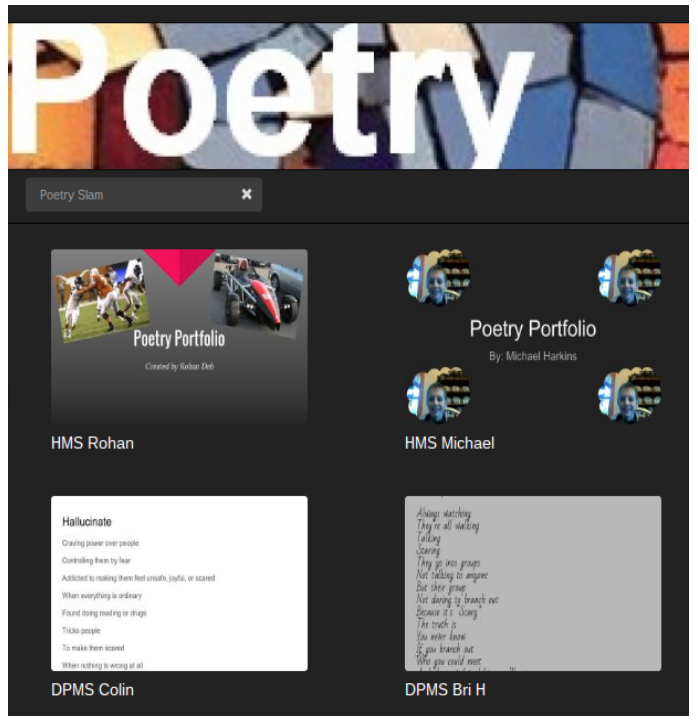
To make this connection possible, I created a VoiceThread group that students and teachers from both schools joined. Then, the students uploaded PDF versions of their Poetry Portfolio Google Presentations and created VoiceThreads. The students were required to read and comment on 10 poems authored by students in the other class. The students spent one class period reading and commenting on the poems and another class period to listening to comments made on their own poems before making changes and corrections to their poems in Google Presentations. The students also recorded themselves reading their poems out loud to practice fluency.
Most of the students utilized the text comment option in VoiceThread. The students wrote thoughtful comments and made personal connections to the poets. When the students recorded audio or video comments, they were able to use the pencil tool to highlight specific parts of the poem.
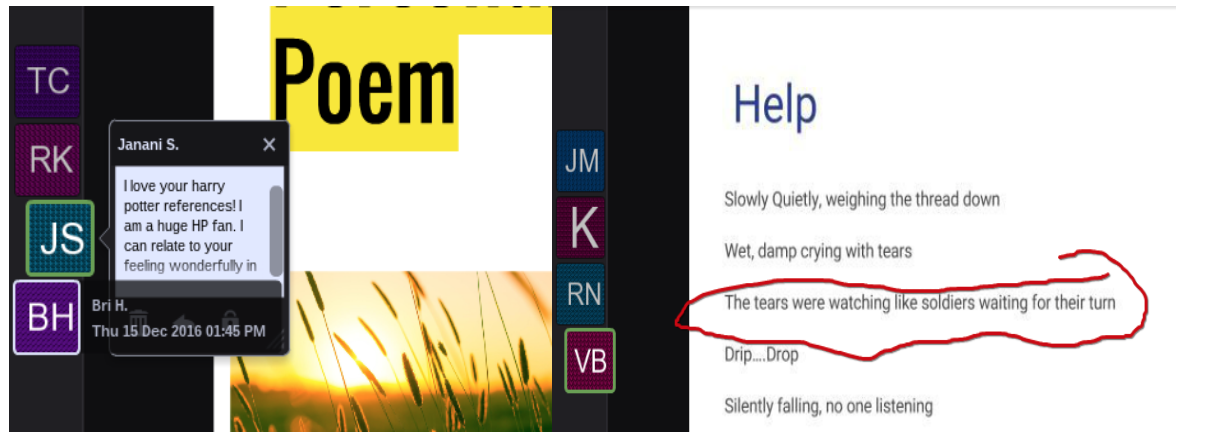
Through the use of VoiceThread and Google tools, Jaime, Shauna, and Donna were able to engage their students in an activity that bridged a 999 mile gap to provide them with an authentic audience of their peers. The students took pride in their poems, took pride in their comments during peer review, and took pride in their performances during the Slam.
About the Author:
Mary Ellen Davies is a Computer Support Teacher at Hillsborough Middle School in Hillsborough, NJ. Prior to this, she taught German for 8 years. She is a VoiceThread Certified Educator.

We’re committed to making VoiceThreading easier, more versatile, and more powerful. We want to share with you how far we’ve come in the past 6 months and where we’re headed in the new year.
New Features in 2016
Retrieving Deleted Work

When you delete a VoiceThread, it goes into your Trash. If you need to retrieve a VoiceThread that has been deleted recently, just go back and restore it from the trash. You can continue using it normally as if it had never been deleted.
Creating collaborative VoiceThreads got much easier this year. Now you can allow your commenters to also add their own slides to your VoiceThread. They can contribute slides, but they can only alter or delete what is theirs, and you can always see who added each one.
Self-Repairing Sharing

If you try to open a VoiceThread that hasn’t been shared with you, you’ll see the option to request access to it. Just select the level of access you’d like, and the person who created that VoiceThread will be notified of your request. That person can then approve or deny your request with a single click.
Learn more
Mobile Updates


- Upload videos and multiple slides at once into a VoiceThread.
- Add files directly from Google Drive and Dropbox on iOS devices. Coming soon for Android!
- Create/edit VoiceThreads more easily with a streamlined workflow.
Search for a specific person’s comments on your VoiceThreads. This can help with assessment, managing large conversations, or just hearing more of what that person has to say.
Re-use past work and merge projects more easily by importing slides from one VoiceThread into another and including all comments on those original slides.
Create Audio Slides

While VoiceThreads are usually conversations around an image, document, or video, sometimes you just want to kick off a conversation without having to upload anything. Now you can use your microphone to record a simple audio slide without having to upload any media at all.
Kaltura Integration

Integrate VoiceThread with your institution’s Kaltura License to quickly and easily pull your video content into VoiceThread. This is a great way to have dynamic conversations around the content you’re already creating. Contact us if your institution has a Site or District License with VoiceThread and would like to integrate with Kaltura.
Sub-Groups

Organize your large courses into smaller groups of students, create individual groups for specific assignments, or even organize your course by week. Creating sub-groups within your main course group allows you to further organize the content you’re already using.
Quickly and easily jump to the first unheard or unseen comment on your VoiceThread by clicking on the new-comment notification. This will help you save time when you have many new comments to view.
Upgrades to the Custom Homepage

Schools, districts, departments, and institutions with VoiceThread licenses can build a customized webpage at their VoiceThread domain. Now you can create a simple ThreadBox to use as your custom homepage. Showcase exemplary work from your members, advertise how VoiceThread is being used at your institution, or create a portal for your users.
Security & Infrastructure

We’re always evolving and improving VoiceThread’s security. In addition to that day-to-day growth last year, we improved VoiceThread’s overall stack security by becoming CIS benchmark compliant.
Upcoming in 2017
No More Flash!
The Flash platform, which powers the most highly interactive experiences in VoiceThread, has been slowly reaching its end of life as a web technology. VoiceThread began a carefully planned move away from Flash over two years ago, and we will have a beta version of the full transition by summer of 2017. The essential VoiceThreading experience will not change significantly, but using VoiceThread in a web browser will no longer require Flash. The result of this transition will be a more secure and intuitive experience overall. As with the other technology transitions we’ve managed over the last decade, we will work hard to make sure the change is as graceful as possible and that users retain as many options for web browsers and versions as possible.
VoiceThread Courses
If you’re teaching in VoiceThread, you probably use groups to organize your course sections or various classes. You’ll still be able to do that, but we’ll also be introducing a true VoiceThread Course that will include a number of features that traditional groups do not.
- Management of Content
Set the order of VoiceThreads in your course and even break them into multiple modules or weeks for better organization.
- Scheduled Release of Content
Create all of your VoiceThreads before the course starts, but then set dates and times for when they will be made available to students. You won’t need to log on and share them manually as you do with groups. You can even schedule when those same VoiceThreads become unavailable so that students can’t access them after a due date or deadline.
- **Course Copying
**After you’ve built a great template course, easily copy it to use in multiple sections, multiple semesters/years, or even hand it off to other instructors who may be teaching the same course.
- Assessment
If you use VoiceThread through your Learning Management System (LMS), you know that some graded assignments are already incorporated. These same assignments will be available outside the LMS, and we’ll be introducing a number of other grading options including group assignments, in-line quizzes, and peer review assignments. VoiceThread will offer a grade book that you can opt to sync with your LMS or use on its own.
- *Analytics
*Track how users are interacting with your course content to learn what works and which students might need a nudge in the right direction.
Accessibility
One of our core values at VoiceThread is to make learning interactions better for everyone. Teaching students using plain text alone is not accessible and is no longer an acceptable default policy for teaching and learning in the 21st century. Universal Design for Learning principles dictate multiple modes of interaction and information be made available, and VoiceThread makes this simple to do. We know that there are still special needs that must be accommodated in a media-rich environments. We’re constantly evolving to improve the experiences of users who are blind, are deaf or hard of hearing, are dyslexic or experience other learning differences, or don’t have access to advanced hardware or connectivity. Over the next year, we’ll be introducing sharing to VT Universal and more closed caption options.
Mobile
More and more learning happens on mobile devices. This presents some unique challenges when you’re working with audio, video, recording, annotations, and real-time updates, but we’re up to those challenges! VoiceThread’s app for iOS and Android continues to evolve for better stability and reliability all throughout the year. We’ll also be adding more media import options and tighter LMS and grade book integration so that it’s easier for students to submit their assignments on their mobile devices.
Security & Infrastructure
We take security very seriously, and that means our job is never done. We’re always working to improve our own practices and architecture, stay ahead of any issues by auditing our systems regularly, and paying close attention to the needs of our users. A major goal for 2017 will be movement toward full at-rest encryption.
Thank you for helping to drive our growth and evolution! We couldn’t do what we do without your feedback and support. Happy VoiceThreading!


This is a guest post by educator and VoiceThreader, Andrea Plato.
When the bell rings at the end of the day and my students scoot out the door, I often reflect on the events of the day. I think about the discussions, clever comments, and insight my students share. The bad news is I can’t remember exactly what was said in the moment, and I feel like I’ve lost a treasure trove of ideas. I strain my brain trying to recollect the moments that impressed me. With a VoiceThread, I’m able to capture my student’s ideas and conversations in the cloud. In the past, my students have created and presented projects to the class and we just moved on from there. With a VoiceThread, the students and I are both able to reflect on projects more than once. Their projects and presentations are archived and can be replayed like a rerun of a favorite television program.
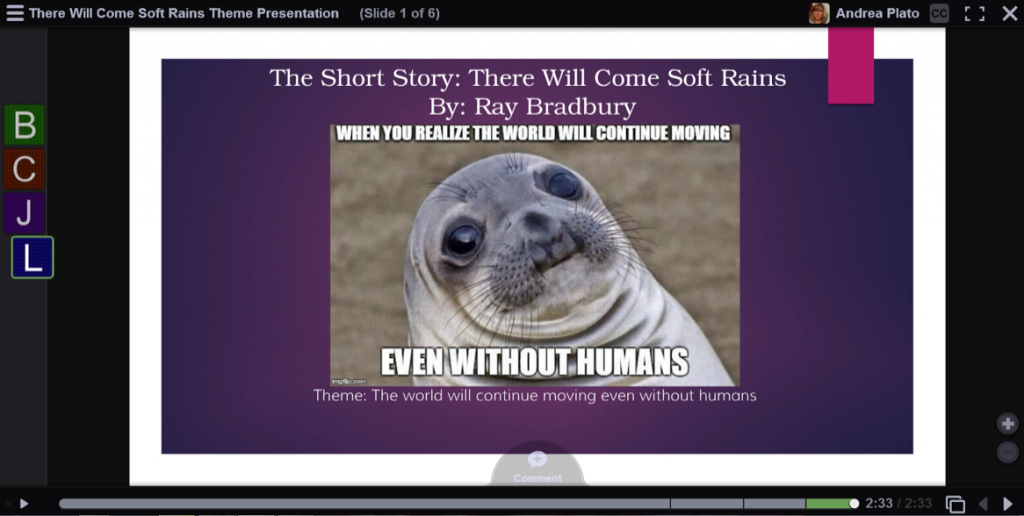
This year my students created presentations related to a theme found in a chapter of Ray Bradbury’s, The Martian Chronicles. Students created a presentation explaining how the theme was depicted in chapter of their choice using textual evidence. They also created what we called a theme meme because kids love memes and so do I. This included the theme along with an image related to their theme. The next step was for group members to work individually to find an example of evidence of the theme in today’s world. Each piece of evidence came from a different source like movies, songs, newspapers, or photographs.
We used VoiceThread as a presentation tool. Students viewed and offered feedback on the project. Students could hear what themes and messages their classmates felt Ray Bradbury was conveying in each chapter and connections students made to the real world. This also was a chance to see how other groups constructed projects. My students seemed more engaged as they viewed the VoiceThread. Students were impressed with the different options for recording comments. The doodling feature on the video recording was a big hit. The advantage with a variety of multimodal options is that students can personalize how they formulate their responses. My camera shy students chose to type their response.
VoiceThread is an amazing tool. It’s a tool that can enhance any project. I’m excited to find new ways to implement VoiceThread in my classroom.
About the Author
Andrea Plato is a 7^th^ Grade ELA teacher at a gifted and talented magnet school in League City, Texas.
This is a guest post by educators and VoiceThreaders, Dr. Thom Tomlinson and Ashley Jo Allen.
We are a project-based learning, early college high school in Raleigh, North Carolina. Over the weekend of October 8th our beautiful city received a visit from the knave Hurricane Matthew. Matthew’s flood waters engulfed our school building, turning an award winning building into an uninhabitable wreck. There may be places where people would give up and cry about the unfairness, Vernon Malone College and Career Academy is NOT such a place.
The school district, community college and our business partners worked with our administration to create a plan for continuing our work. The plan resulted in our students being spread out over four different campuses within our county. Dr. Thom Tomlinson, our Honors Biology teacher and current Kenan Fellow, wanted to create a project that engaged and connected our kids, parents, and community during this time of transition. VoiceThread was the perfect tool to capture the oral and visual components of this project in a collaborative manner. Students typically present their work to an authentic audience of students, teachers, parents, and community members. VoiceThread provided us with the means to create a presentation from multiple classes and to share the work with students and faculty on all four campuses.
The What’s Bugging You? Project began as a hook to a unit on cell function and structure. Students seemed enthusiastic about the guiding question, “What microbe causes the most terrifying death?” Students researched various horrible manners of death by microbes and selected one for their research and art. Anyone who stopped by class witnessed students 100% engaged in this activity. Near the end of the project, students expressed concern for how they were going to share the work and receive feedback for revision. Silver Hawks learn to value the feedback of other students, the faculty and community partners, and rely on it to complete their final product. VoiceThread was our best option for overcoming geographic separation and allowing students to receive feedback. VoiceThread then became the platform for displaying their creative treatment of the driving question.
About the Authors
Thom Tomlinson, Ph.D. is a science teacher at Vernon Malone College and Career Academy in Raleigh, NC and a current Kenan Fellow. You can follow him on twitter at @tomlinson_thom.
Ashley Jo Allen, M.Ed. is an Instructional Technology Facilitator at Vernon Malone College and Career Academy in Raleigh, NC. Prior to this, she taught high school math and received her National Boards in 2010. Find her on twitter at @ashleyjoallen and you can follow Vernon Malone College and Career Academy here: @vernonmalonecca.

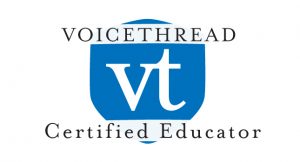
We invite you to join the hundreds of VoiceThreaders who have already been certified. Unlike other edtech certifications, this course is not a rubber stamp for work you’ve already completed. Our course is designed to give you a genuine learning experience through creating, experimenting, and most of all, fun.
Whether you are a novice or advanced user, this course will help you become an expert VoiceThreader through personal guidance from the facilitator, group discussions, and hands-on activities.
You can add yourself to the wait list for the course here:
About the Course
– How much does it cost?
The registration fee is $199.
– How do I get certified?
After completing the 2 week online course, you will begin working on your capstone project. This will be a real-world project that you create with your students, colleagues, or the faculty members you train. Once your capstone project has been reviewed and approved by the VoiceThread team, you will become certified! You will receive a digital badge to display on your website or e-portfolio along with public recognition on our VoiceThread Certified Educator page.
– How many hours will it take to complete?
It depends on how familiar you are with VoiceThread, but for novice users, expect to spend 6-8 hours each week reviewing tutorials, participating in discussions, and completing short exercises.
* Note that certification is dependent on completing the post-course capstone project. You will be responsible to design, implement, and submit a real-world project for your VCE credential.
– How is the course structured?
The course is completely asynchronous, so there are no specific meeting times. It will include a live pre-course info session with Q&A, two weeks of hands-on activities, and a capstone project. The course will be hosted on Canvas and will include a series of tutorials, hands-on exercises, and discussions about lesson design, assessment design, safety and security, and more.
– What are the learning outcomes?
By the end of this course, you will have experience using every feature available to license holders, and you will be empowered to create dynamic, engaging lessons and assessments using VoiceThread.
– Is there an enrollment cap for the course?
Yes. We are capping the course enrollment at 30 participants so that we can give each educator personal feedback, guidance, and support throughout the course.
– Who is the instructor?
Our instructional designer, George Haines, will facilitate the course. George is a former K-12 teacher and higher ed instructional designer who has taught a variety of online courses.
– When does it run?
We will be offering cohorts throughout the year, but space is limited!
If you have any questions about the course that aren’t answered above, drop us a note at info@voicethread.com and we will be happy to answer them.
We look forward to working with you on your journey to becoming a VoiceThread Certified Educator!
This is a guest post by Educator and VoiceThreader, Mary Ellen Davies.
In my 10 years as an educator, I have learned that there is definitely a difference between “teacher cool” and “student cool.” When “teacher cool” and “student cool” are the same, the result is something incredible!
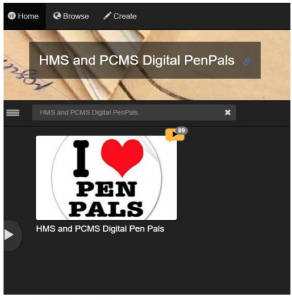 At the start of the school year, Daynon Blevins, an 8th grade literacy teacher at Hillsborough Middle School in Hillsborough, NJ, mentioned to me that he would like to find pen pals for his class. He was interested in giving his students an authentic audience to communicate with to share original ideas and learn about life in another part of the United States. A post on Google+ connected us with Brandi Metts, a Computer teacher from Pierce County Middle School in Blackshear, GA. After a quick brainstorming session, both teachers were on board with connecting their students as VoiceThread digital pen pals.
At the start of the school year, Daynon Blevins, an 8th grade literacy teacher at Hillsborough Middle School in Hillsborough, NJ, mentioned to me that he would like to find pen pals for his class. He was interested in giving his students an authentic audience to communicate with to share original ideas and learn about life in another part of the United States. A post on Google+ connected us with Brandi Metts, a Computer teacher from Pierce County Middle School in Blackshear, GA. After a quick brainstorming session, both teachers were on board with connecting their students as VoiceThread digital pen pals.
We paired the students, enrolled them in our shared VoiceThread group, created a VoiceThread and the interaction began. The second slide in the VoiceThread was the first prompt. The students were to share basic personal information including favorite movie and music group, extra-curricular activities, other interesting information and any questions they had for their pen pal.
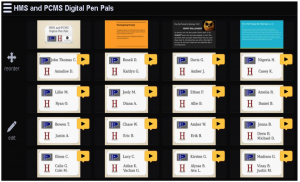
Some of Brandi’s students recorded first and Daynon’s students were so excited to listen to what their pen pals said and have some questions to respond to. The students have responded to 3 prompts so far and the interactions have gone beyond the expected singular response to each prompt. We’ve checked out the time stamps when the students record their responses; they are continuing the discussions outside of class-time and are recording new responses during free periods and at home!
The real magic happened when Daynon’s students signed in to VoiceThread to record their initial posts and comments from Brandi’s students started appearing. The excitement from Daynon’s students about the “real-time” connection was amazing! Even though the students had already finished their initial recording, they were eager to listen to their pen pal’s recording and respond.
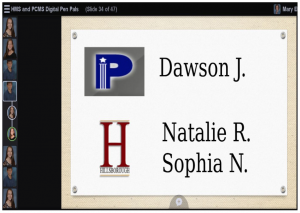
The students in both classes are excited about this connection and engaged in the activity. What more could a teacher want? Oh, maybe to hear “This is so cool!” from nearly every student in your class. VoiceThread has helped Daynon and Brandi connect their students and find the sweet spot where “teacher cool” and “student cool” meet.
About the Author:
Mary Ellen Davies is a Computer Support Teacher at Hillsborough Middle School in Hillsborough, NJ. Prior to this, she taught German for 8 years. She is a VoiceThread Certified Educator.
** **
We often hear that there are two fundamental types of courses: face-to-face and online. Because so much of what students experience in a typical online course is text-based, we can understand why this perception exists. We don’t see such a clear distinction between the two. With VoiceThread, teachers can design lessons that traditionally were only seen in a classroom setting.
Converting a Math Lesson
The Teaching Channel recently posted a great math lesson about using manipulatives to teach place value concepts. Students worked with magnetized counters and a ten frame on a dry-erase board. This type of lesson can be hard to replicate in online course spaces.
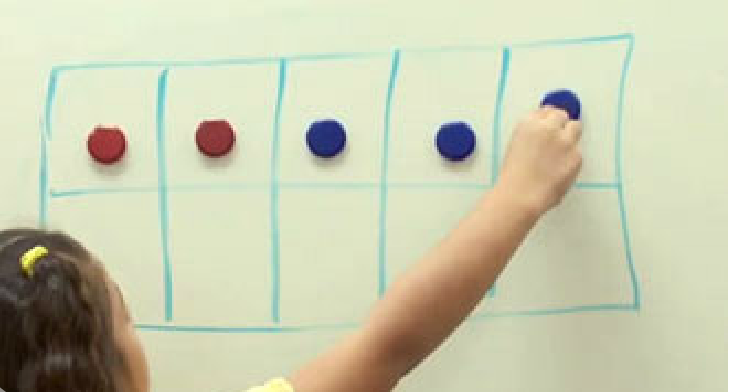
With VoiceThread, a teacher can upload an image or document with a ten frame and students can use the doodle tool to participate in the same learning experience. Unlike in a time-constrained classroom environment though, students can take as much time as they need to reflect and work through the lesson on VoiceThread.
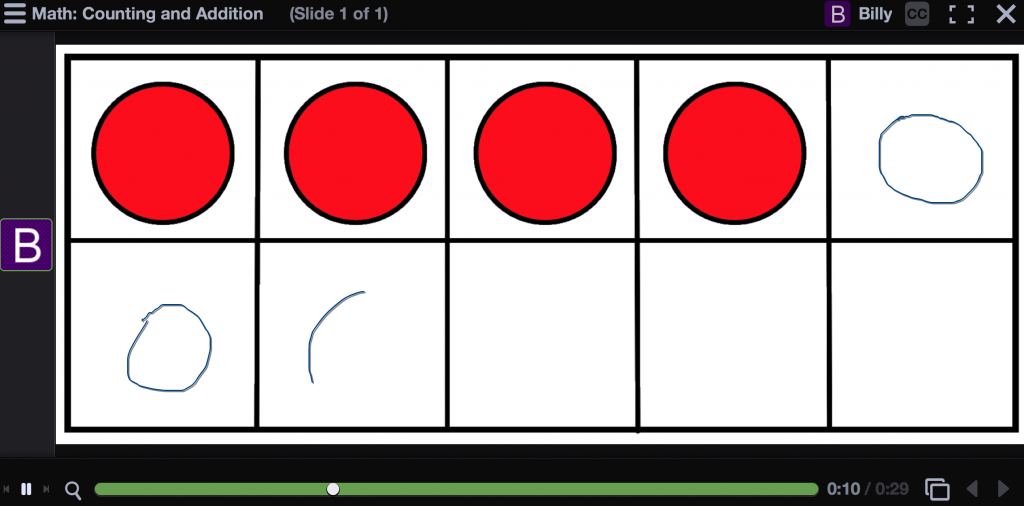
Converting a Literature Circle
Engaging students in a robust discussion about a lesson can be one of the most rewarding aspects of classroom teaching. In a face-to-face class, it can be hard to make sure everyone is involved though. With VoiceThread, every student can share their ideas, reflect on what they hear and engage asynchronously. In the thread below, you can see how every student has a chance to be heard.\
Converting Science Lab Presentations
When students do research and present their findings to the class, the experience can aid learning in a number of ways. Students get to see the work of their peers, they learn to organize their thoughts and present them in an understandable way, and group discussions can bloom. The downside of doing this in a live classroom is that student presentations can be very time consuming and take multiple class meetings to complete.
When students present their research findings on VoiceThread, time pressures are taken out of the equation. Students can complete their peer review on their schedule and they have time to re-do and perfect their own presentations.
Have you converted one of your face-to-face lessons to VoiceThread? We’d love to hear your ideas in the comments section below!
This is a guest post by educator and VoiceThreader, Dr. Karen Wells.
Teaching graduate-level biological sciences in the online classroom can be challenging! As an online instructor, I’m always looking for ways to “translate” enriching experiences from the brick-and-mortar classroom into the virtual classroom. One essential component for graduate-level instruction is the Journal Club: students critically read and evaluate the primary literature and then engage in a presentation and discussion of the research. This is a bedrock activity that I’ve struggled to appropriately structure for my online courses. For many years, I used traditional text-based discussion forums for my online Journal Clubs, but I found them to be unsatisfying at multiple levels: the inability to directly interact with the figures and data while at the same time posting input; insufficient interactivity between/among students and instructor; inadequate depth of content in student posts; a lack of high-quality engagement.
Luckily, VoiceThread (VT) to the rescue! Over the past few years, I’ve harnessed the power of the VT platform to overcome these previous weaknesses and transform my online Journal Clubs into the highly interactive and engaging activity I’ve always envisioned! My virtual students are now able to explore bioscience research at a depth I found elusive within the text-based format.
Here’s the Journal Club “formula” I currently use in my online courses, and it’s also the one I used for my VoiceThread Certified Educator Capstone Project:
* Student leaders submit PPTX slides that contain high-quality images of pre-assigned figures from the primary research article. I upload these slides into VT, and this then serves as the central media for our discussion. (Note: Starting on 10/28, students can add slides to a thread that you create without having to give them full editing access.) These same student leaders also post some initial discussion questions as starter (audio) comments on their VT slides.
* Throughout the week (one unit), the whole class works together to critically read, evaluate, and discuss the data within the research article. Each student is required to make two substantive posts to the Journal Club, at different times and to different figures. Each content-based post must be audio- or video-based, be 1-2 minutes in length, and include doodling as a means to draw attention to specific relevant data within the images on the slides.
* For the duration of the Journal Club, each student leader monitors & facilitates the voice-based discussion of his/her assigned figure by providing additional discussion questions, responding to classmate input, steering the discussion in relevant directions, and providing a closing audio post shortly after the Journal Club ends. As the instructor, I constantly monitor the entire VT discussion and provide feedback or questions as needed.
Here’s an abbreviated example of a recent VT Journal Club from one of my cell biology courses. In the interests of privacy, all student responses have been deleted. Unfortunately, this removes the best portion of the VT! But I’m hopeful that my comments, along with the central media, will provide some sense about the power of the platform and the way it can be applied.
About the author:
Dr. Karen Wells is a Senior Lecturer with the Center for Biotechnology Education and the Advanced Academic Programs at the Johns Hopkins University. She teaches biochemistry, cell biology, physiology, and neuroscience courses, at the graduate and undergraduate levels, both in the classroom and online. Karen is a VoiceThread Certified Educator.






























